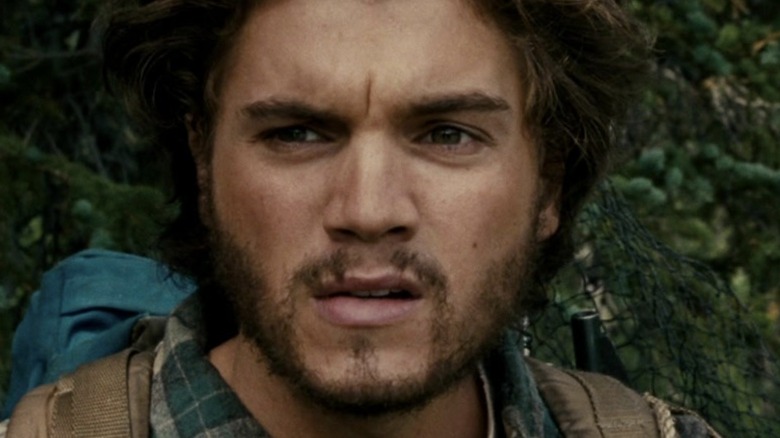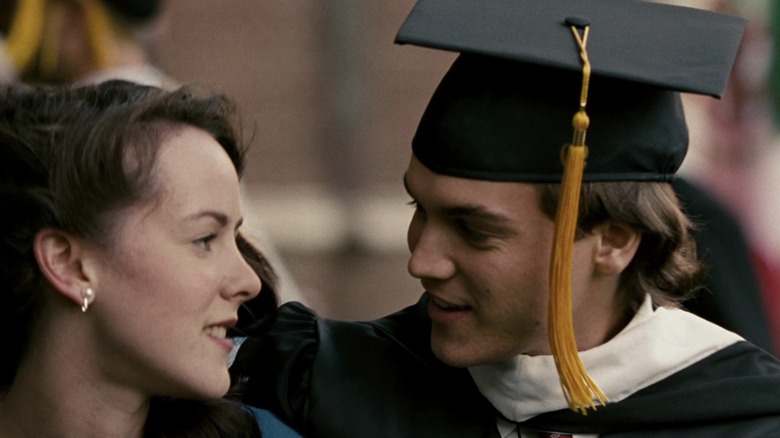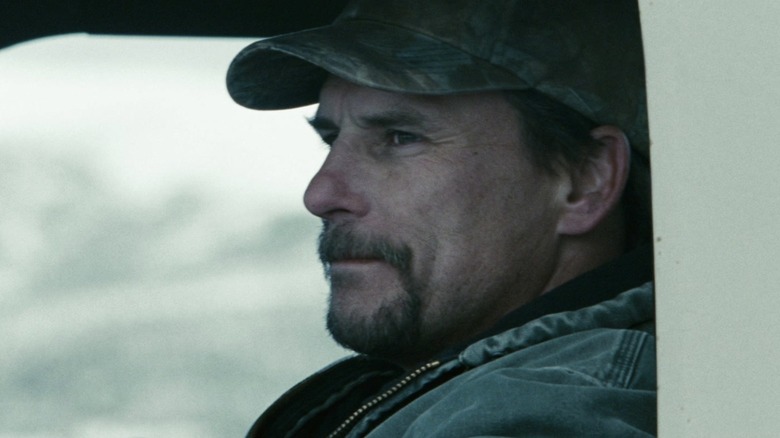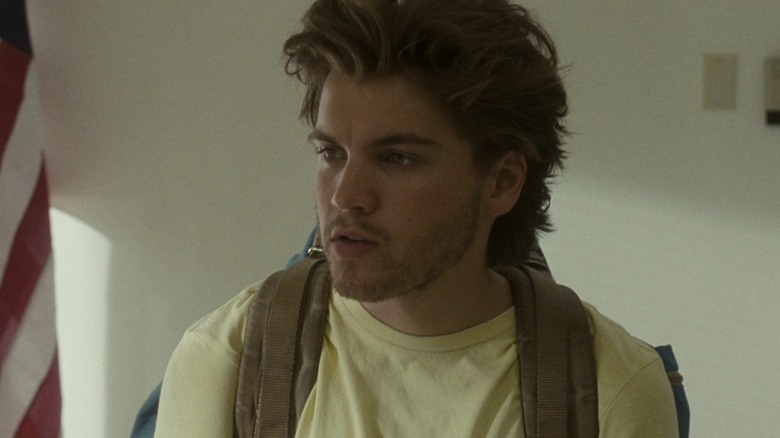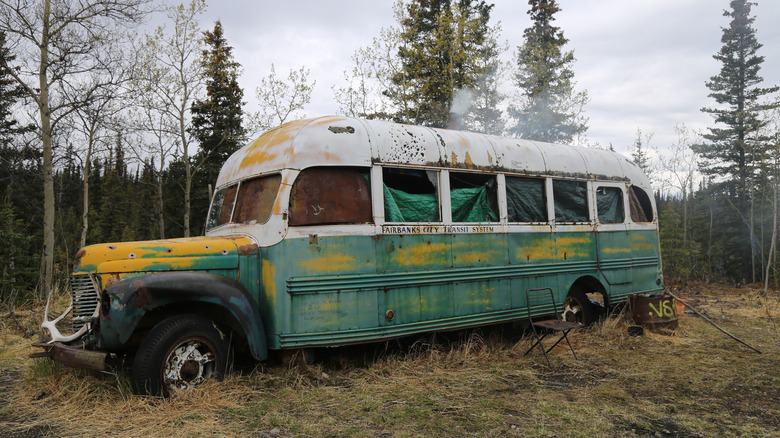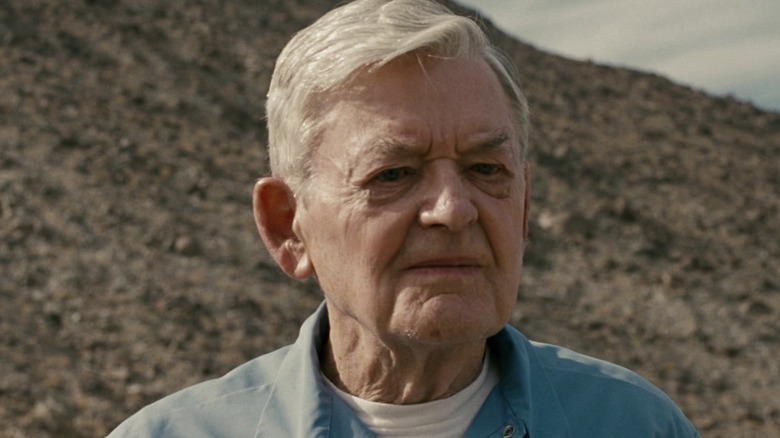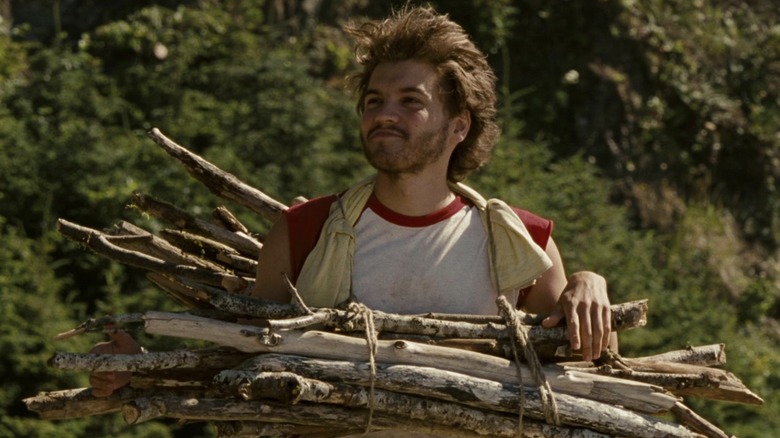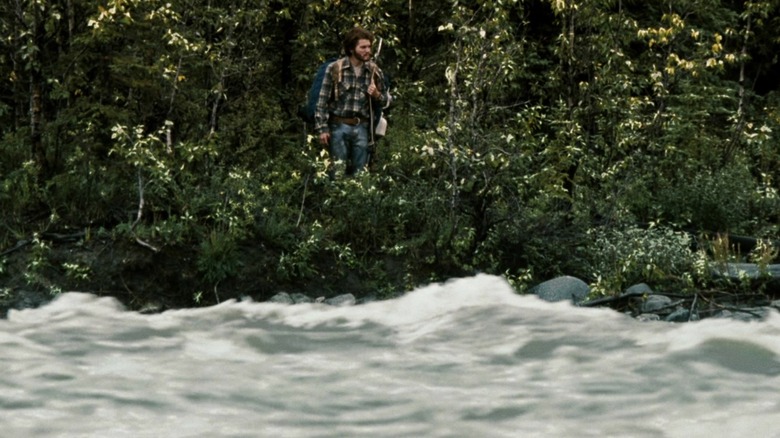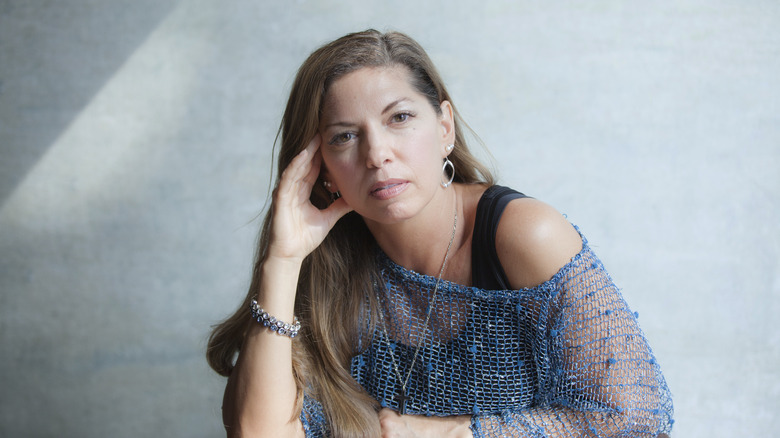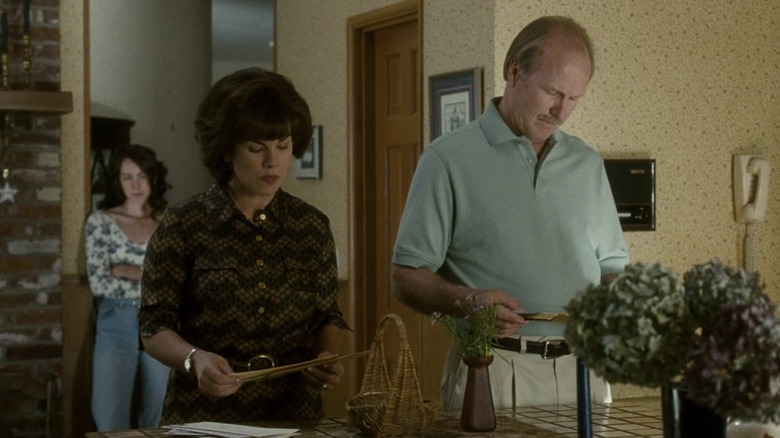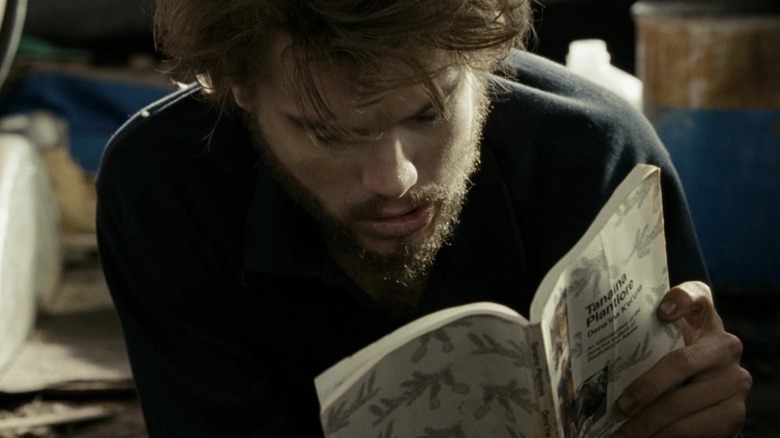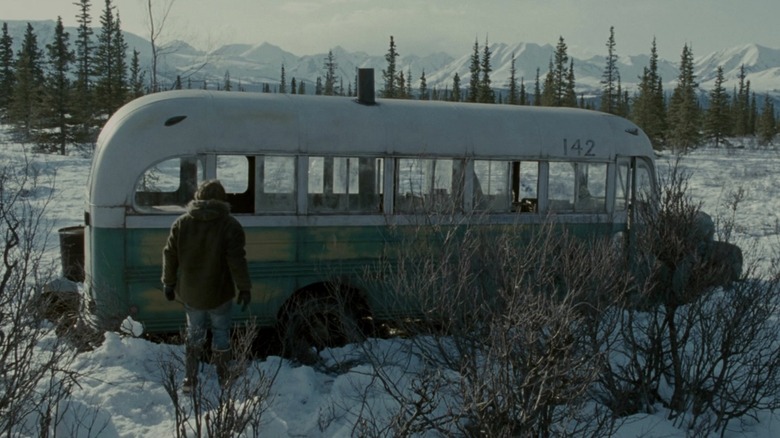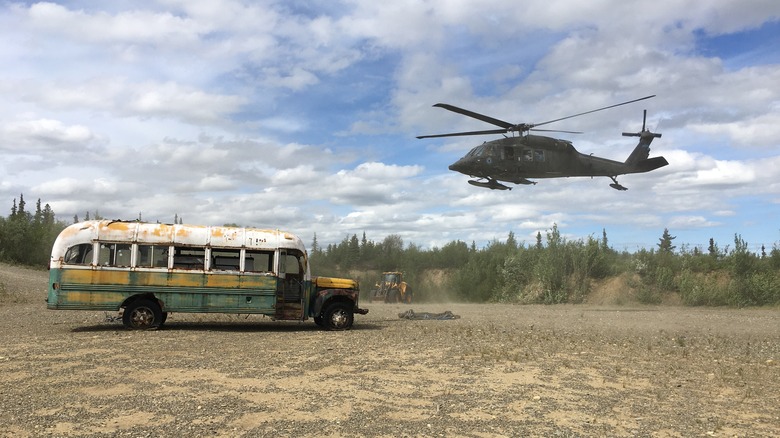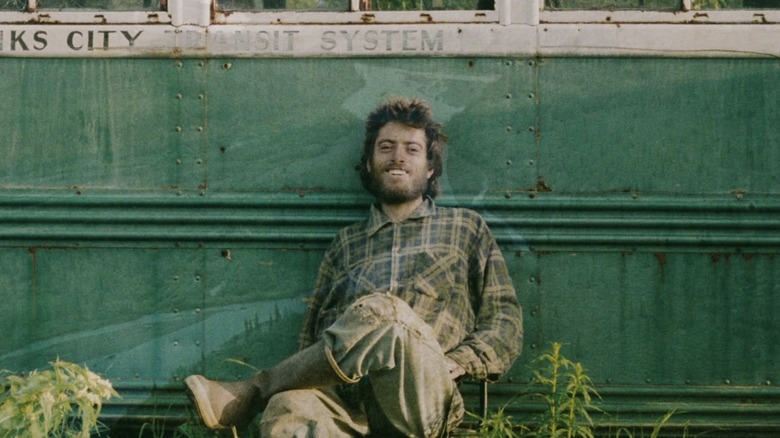Everything Into The Wild Doesn't Tell You About The True Story
Adventure writer Jon Krakauer's book "Into the Wild" is a journalistic yet personal examination of the life and death of Chris McCandless. After graduating college, McCandless donated his life savings, cut off contact with his family, and vanished, becoming a nomad and living under the assumed identity Alexander Supertramp. For two years he explored America, meeting other travelers and friends before venturing into the Alaskan wilderness and perishing at 24 years old.
Sean Penn read the book twice in 1996 and immediately knew he wanted to make it into a film. As reported by The Los Angeles Times, Penn spent the next decade convincing McCandless' family to sell him the rights to Chris' story. The 2007 film adaptation, "Into The Wild," is an elegiac celebration of McCandless' (Emile Hirsch) wanderlust and a glimpse of his tragic death, told from McCandless' perspective and through his sister Carine's (Jena Malone) narration. Penn's film was nominated for two Academy Awards and secured a "fresh" rating on Rotten Tomatoes. Krakauer told The Los Angeles Times, "When [Penn] showed me the rough cut, I wanted to kiss him, I was so happy."
Some, like writer-director Penn, mythologized McCandless, depicting him as an idealistic wanderer who eschewed capitalism and hustle culture while embracing an adventurous life lived to the fullest. Others believe McCandless was a selfish and arrogant rich kid who thought he could survive the wilderness of Alaska, only to find himself tragically unprepared. Keep reading to explore everything "Into The Wild" doesn't tell you about the true story.
The film skips McCandless' high school and college years
"Into the Wild" is a very long film, running two hours and 28 minutes, but it couldn't possibly include everything covered in Jon Krakauer's book. According to Outside, Chris McCandless was the captain of his high school cross-country track team, and enjoyed creating punishing workouts that took him and his teammates into unfamiliar territory to test their limits and endurance.
He couldn't bear the inequities he saw in the world. His mother Billie told Outside, "Chris didn't understand how people could possibly be allowed to go hungry ... He would rave about that kind of thing for hours." Chris also took action on these beliefs. As reported by Outside, he brought a homeless man to live in the family's camper once. As depicted in the film, McCandless graduated with honors from Emory University, where he contributed intense editorials on subjects he was passionate about to the school newspaper (per The A.V. Club).
The PBS documentary "Return to the Wild" reveals that solo treks across the U.S. were nothing new for McCandless when he vanished in the summer of 1990. Five years earlier, after graduating high school, he bought his Datsun and drove cross-country. According to his father Walt, Chris was gone all summer, rarely checking in. Walt told The New York Times, "He was always an adventuresome, pretty self-contained individual ... it's important to realize that the trip he didn't come back from wasn't his first adventure."
His driver to the trailhead tried to dissuade him
At the beginning of the film version of "Into the Wild," we see Chris McCandless hitchhiking into Fairbanks, Alaska before he's dropped off at the Stampede trailhead. The driver gives McCandless a pair of rubber boots to keep his feet dry, telling McCandless to call him if he makes it out alive. Jim Gallien is the man who dropped McCandless off, and he played himself in the film.
Like many before him, Gallien tried to talk McCandless out of his foolhardy plan. Gallien told NPR, "I said the hunting wasn't easy where he was going ... When that didn't work, I tried to scare him ... But he wouldn't give an inch. He had an answer for everything I threw at him." Walt McCandless wouldn't have been surprised by this, telling Outside, "If you attempted to talk him out of something, he wouldn't argue. He'd just nod politely and then do exactly what he wanted."
McCandless gave Gallien his watch at the trailhead, despite Gallien's protestations. As reported by NPR, McCandless told Gallien he would throw the watch away, saying, "I don't want to know what time it is. I don't want to know what day it is or where I am. None of that matters." Emile Hirsch told The East Bay Times that he actually wore McCandless' watch in the film after Gallien lent him the timepiece.
McCandless has been accused of legal infractions
The Anchorage Daily News explored the legal infractions that McCandless was accused of, beginning with McCandless abandoning his car in Arizona, as depicted in "Into the Wild." This article claims the car had an expired registration, no insurance, and was left in a region of the park closed to cars.
The New Yorker reported in 1993 that McCandless got a ticket for hitchhiking after abandoning his car in Arizona and alleged that he broke into a cabin in the Sierra Nevada mountains to steal food. In the film, we see McCandless dismiss rules repeatedly — as when the park ranger says he needs a permit to kayak the Colorado River — so some of these accusations are plausible. According to NPR, McCandless was scornful when Jim Gallien asked if he had a hunting permit before hiking the Stampede Trail, saying, "Hell, no. How I feed myself is none of the government's business. F*** their stupid rules."
According to Jon Krakauer's book, McCandless was also arrested for hopping trains in Colton, California. The accusations didn't stop after McCandless disappeared in Alaska. The Anchorage Daily News, which called McCandless a poacher, suggested that McCandless broke into and vandalized cabins in the area while living on Bus 142. Gordon E. Samel, one of the hunters who found McCandless' body, suggested that the moose McCandless shot in Alaska was caribou (via Reuters). McCandless' journal hints that he killed it at the beginning of June, meaning it was killed out of season (via Huntin' Fool).
McCandless' parents visited Bus 142
The screen adaptation of "Into The Wild" explores nothing that happened after Chris McCandless' death, other than sharing when his body was found by hunters. According to The A.V. Club, Jon Krakauer's bestselling book explores McCandless' life and death, as well as how his death affected the people he left behind. Krakauer interviewed McCandless' family, and the people he met during his travels, to piece together what happened to McCandless during the two years preceding his death. During his research, the writer developed a relationship with the McCandless family.
According to Treehugger, after McCandless' death, Krakauer and McCandless' parents visited Bus 142 via helicopter. Walt and Billie installed a memorial plaque on Bus 142, leaving an emergency kit, and a note asking visitors to please "call your parents as soon as possible." During the 2014 PBS documentary "Return to the Wild," the film crew followed McCandless' sister Carine and two of their half-sisters as they visited Bus 142, 22 years after his death. This was Carine's third visit to the bus, but it was the first time their half-sisters saw where their brother died.
After learning of Chris' death, Ronald Franz became depressed
According to NPR, the film's Ron Franz (Hal Holbrook) was based on a real person. Holbrook was nominated for an Oscar for his performance in "Into the Wild." Tripline claims Franz's real name was Russell Fritz. As reported by Treehugger, McCandless had a huge effect on Franz/Fritz, the elderly man who offers to adopt McCandless in the film before he departs southern California for his ill-fated trip to Alaska.
We only briefly meet Franz in the film, but Krakauer's book further explored the impact that meeting McCandless had on Franz's life. The New York Times reports that after parting ways, McCandless wrote Franz, saying, "If you want to get more out of life, Ron, you must lose your inclination for monotonous security and adopt a helter-skelter style of life that will at first appear to you to be crazy." After receiving a letter from McCandless, Franz put his belongings into storage and set out into the desert, inspired to shake things up.
In reality, Franz seemed to sit in the desert waiting for McCandless to return for eight months. In Chapter 6 of Krakauer's book, we learn that while returning from the desert, Franz picked up a couple of hitchhikers who told him of McCandless' death in Alaska. After learning of the young man's death, a distraught Franz renounced his faith in God, claiming to be an atheist, and drank a bottle of whiskey after decades of sobriety.
The real Chris McCandless was not the film's idealistic free spirit
As reported by The A.V. Club, Jon Krakauer's book acknowledged McCandless' inflexible and argumentative nature, calling him a "highly polarizing subject," while also depicting him as charismatic and extroverted. Krakauer told NPR, "He was an intense kid. He didn't see the world in gray at all, everything was black and white, right or wrong, and he was a young man who wanted to test himself."
Sean Penn's "Into the Wild" hinted at McCandless' stubborn side by showing McCandless arguing with his parents about not wanting them to buy him a new car for graduation, dismissing the need for a permit to kayak the Colorado River, and refusing much of the charity and help that flowed his way. While the film doesn't ignore his stubbornness, it characterizes McCandless as a more laid-back, idealistic free spirit who rejects his parent's affluent lifestyle and the rat race.
Walt McCandless told Outside, "He was good at almost everything he ever tried, which made him supremely overconfident." Tragically, it was McCandless' inability to accept help and heed good advice that led him down the lonely and tragic path to his death on Bus 142.
Chris McCandless could have crossed the river downstream
Late in "Into the Wild," McCandless packs up his stuff and cleans up under a makeshift shower before hiking toward society after surviving off the land for over two months. When McCandless reaches the river, which was frozen when he arrived, he sees the hat Jan (Catherine Keener) knitted for him, skewered on a branch where he left it to mark his route. Unfortunately, McCandless returns to the bus after failing to cross the Teklanika River, which is swollen from snow melt.
Brent Keith, an Alaskan guide, told Men's Journal, "I just don't get why he didn't stay down by the Teklanika until the water got low enough to cross. Or walk upstream to where it braids out in shallow channels. Or start a signal fire on a gravel bar." The New Yorker shared that less than a mile downriver from where he crossed in April, there was a hand-operated tram he could have used to cross the river when he wanted to leave in July.
According to Forbes, a recent study by hydrologists at Oregon State University suggested that McCandless was trapped because of a "freak hydrological event" exacerbated by run-off from the Cantwell Glacier. David Hill, who co-authored the study, told Forbes, "Streamflow in summer 1992 was more variable than usual because of the quick snowmelt followed by periods of heavy rain," adding if he had tried to cross earlier or later in July the results might have been different.
Carine McCandless alleges that she and Chris experienced domestic abuse
Jon Krakauer's book refers obliquely to the McCandless family's toxic dynamic, characterizing their father Walt as "overbearing" and their home as unhappy (per NPR). Carine confided in Krakauer about the abuse while he was researching "Into The Wild," but she told Outside, "I made him promise — before I let him read Chris's letters, before I told him these things — that he wouldn't expose any of it in the book."
By the time Sean Penn was making his film adaptation, Carine was older and more open about the abuse she alleges she and Chris experienced and witnessed growing up. The film depicts domestic abuse in a couple of flashbacks. In 2014, Carine wrote her memoir, "The Wild Truth," revealing more about the alleged abuse. Per Outside, Walt and Billie McCandless have denied the accusations, describing her memoir as fiction.
In the PBS documentary "Return to the Wild," Carine shares letters Chris had sent her, hinting at his plans to disappear and cut off all contact with their parents. Carine told Outside that she didn't write the book to defend her brother or villainize her parents, but because she wanted people to finally know the entire story and understand what Chris was running from and how much pain he was in when he left. Carine told Newsweek, "I hold them accountable for his disappearance. But I certainly don't blame them for his death."
If you or someone you know may be the victim of child abuse, please contact the Childhelp National Child Abuse Hotline at 1-800-4-A-Child (1-800-422-4453) or contact their live chat services.
The film glosses over Walt McCandless' other family
Sean Penn's "Into the Wild" explains how Chris McCandless was devastated to learn that he and his sister Carine were born out of wedlock, while their father was still married to his first wife. The film makes it seem like Walt's first marriage was a long-held family secret and Chris and Carine didn't have a relationship with their half-siblings. This was not the case. In a segment for ABC News, Carine and two of her half-sisters verified that they grew up together, going on family vacations and witnessing domestic violence together.
According to the PBS documentary "Return to the Wild," when Chris was five years old, Walt and his first wife Marcia separated and she was granted a restraining order because of alleged domestic violence. They divorced, and she moved their children from California, where the kids were born, to Colorado. During summer vacations, they would travel from Colorado to visit their father and half-siblings in Annandale, Virginia, where Walt had moved for a job with NASA.
If you or someone you know is dealing with domestic abuse, you can call the National Domestic Violence Hotline at 1−800−799−7233. You can also find more information, resources, and support at their website.
The cause of McCandless' death has been contested
Per The New Yorker, coroners declared starvation the cause of Chris McCandless' death. The film postulates, much like Jon Krakauer did in his early investigation for Outside, that McCandless had mistaken wild potato for wild sweet pea, which is poisonous. In his book, Jon Krakauer suggested a different conclusion, theorizing that the seeds contained a detrimental alkaloid. Krakauer drew these conclusions from McCandless' journal and the undeveloped photographs he left behind.
Thomas Clausen, the chair of chemistry and biochemistry at UAF, disproved Krakauer's theory, telling Men's Journal, "I tore that plant apart. There were no toxins. No alkaloids. I'd eat it myself." In a 2013 article for The New Yorker, Krakauer doubled down on his hypothesis, referencing a paper using evidence gathered from World War II concentration camps to say that the seed pods of wild potatoes weakened McCandless, making it impossible for him to hunt, forage or hike to the highway.
Per NPR, Krakauer has revisited his theory repeatedly in the years after publishing "Into the Wild," leading to multiple book revisions and lab tests. In 2015, Krakauer believed he had found the answer: an amino acid called L-canavanine. Krakauer co-authored and published a scientific paper with Jonathan Southard, a biochemist at Indiana University of Pennsylvania. Krakauer told NPR, "It screws up your ability to metabolize, so you essentially starve," explaining that this amino acid is in the seed pods, which is why natives only eat the roots.
Into the Wild inspired people to travel to the magic bus
Both the book and the film adaptation of "Into the Wild" have inspired scores of people to hike the Stampede Trail to see Bus 142, where Chris McCandless died in 1992. In the 30 years since his death, the flow of travelers, often referred to as pilgrims, hasn't been staunched. In 2019, Treehugger reported more than 100 people visit Bus 142 annually.
Claire Ackerman, a 29-year-old hiker visiting from Switzerland, died attempting to cross the Teklanika River in 2010. According to the Anchorage Daily News, her boyfriend, a Frenchman named Etienne Gros, claimed Bus 142 was not their destination. But in 2013 Gros admitted to Outside that after being told the Teklanika River was passable by other hikers in Denali National Park, the pair changed their plans. Gros built a memorial along the river where Ackerman died.
Also in 2013, a ranger told Outside that 75% of the rescues in the area occurred on the trail to the bus, saying, "Obviously, there's something that draws these people out here," while adding that the allure escaped them. Carine McCandless and Ackerman's family petitioned for a footbridge over the river, but their request was ignored. The Los Angeles Times reported that Veranika Nikanava and her husband were hiking to Bus 142 when she drowned in Teklanika River in 2019. According to BBC News, numerous other rescue missions and the two deaths finally prompted talk of removing the bus.
Bus 142 was moved from the original location
According to Greenbelly, the Fairbanks City Transit bus in which McCandless spent his final days was brought out to the spot near the Teklanika River by the Yutan Construction Company, which had purchased the decommissioned bus. The company outfitted the bus as a temporary shelter for workers who were building an access road to nearby mines. When the work was done in 1961, the bus was left behind and continued to be used by hunters and hikers traveling through the area.
In June 2020, in response to two drowning deaths and many rescues, the Alaska Army National Guard removed Bus 142 from the location where McCandless perished. As reported by The New York Times, a CH-47 Chinook helicopter airlifted the bus to a nearby location where it was loaded on a trailer and transported to an undisclosed location. Dan Saddler, a spokesman for the Alaska Department of Natural Resources, told the Times, "Mostly, we're glad that we've taken action that will avoid future deaths and injuries and search-and-rescue costs."
Carine McCandless told the Times, "Though I am saddened by the news, the decision made by Alaska D.N.R. was with good intentions toward public safety." In 2021, The Anchorage Daily News reported that at some point in the future, Bus 142 would be displayed at The University of Alaska at Fairbanks' Museum of the North, after the Engineering Learning and Innovation Facility finished preparing the bus for exhibition.
Chris MaCandless' family published a book of his photos
In the PBS documentary "Return to the Wild," Chris McCandless' parents, Walt and Billie, talked about the undeveloped film that was recovered with their son's body and returned to them after his death. Walt said, "Billie couldn't look at them. The pictures. She just couldn't do it. It has hard for me, but I did." Walt shared how he catalogued the images and scanned over 600 pictures depicting Chris' travels during the two years after he graduated college and dropped out of society.
Some of these photos are self-portraits Chris took using a timer, including the portrait we see at the end of "Into the Wild." In 2011, Walt and Billie published a book, "Back to the Wild," featuring Chris' photography accompanied by captions written by Walt. According to Outside, Chris' sister Carine wasn't pleased that her parents published the book, thinking it obscured her brother's tragic truth. Regardless of their motivations, the collection of photos documents Chris' experiences, as did Krakauer's book and Sean Penn's film. Despite Chris' tragic end, "Into the Wild" is often hailed as one of the best movies about people surviving in the wilderness.
